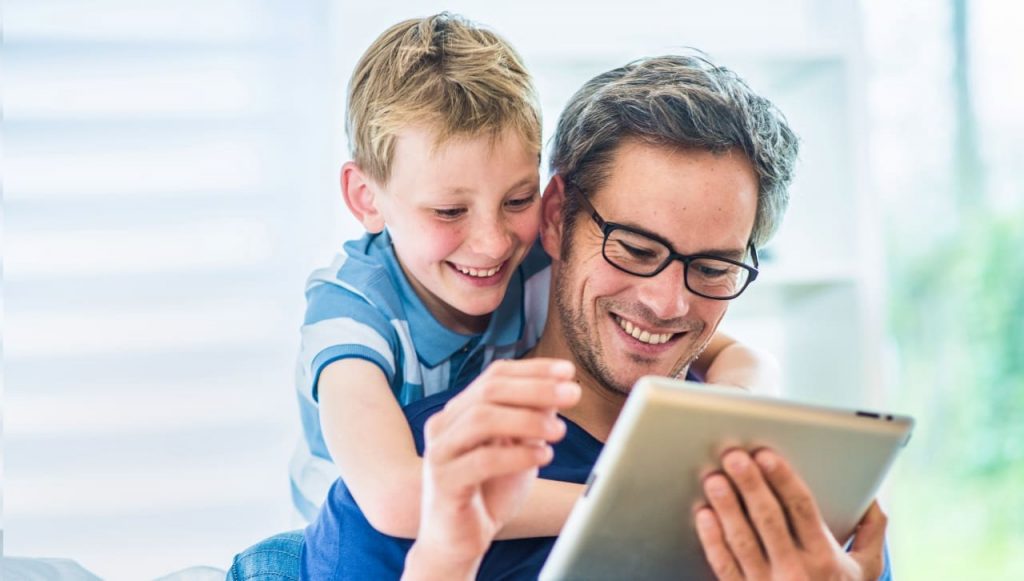Is it really necessary to limit cell phone use?
I know. We hear a lot about screen time and how terrible it is. But at the end of the day it’s so useful to give the toddler an iPad when there are guests over. The teens would genuinely miss out on a big part of their social group’s activity if they weren’t on snapchat. And after all, we use screens all the time ourselves. Why would they be any worse for our kids? Why should we limit cell phone use for our children and teens?
If you’re reading this article though, I’m guessing you’ve already encountered the flip side of that coin. Kids who can’t eat if there’s no cartoon playing, sons and daughters who find the virtual far more engaging than the real and teens struggling with anxiety and depression due to a false understanding of their identity, built on the warped reality of social networks.
It’s not just our kids either. In many cases our kids are picking up on this behaviour first and foremost from us. Our phone is our alarm and morning news, we turn to it for the weather, for recipes, when waiting for something, when we get a notification… you get the idea. Children quickly pick up on the importance of the cell phone in their parents life and feel fully justified in allowing a phone to play a similarly deeply integrated role in their own life.
Parental examples of screen time
It’s not a quick fix, but if we want to have a lasting impact on the way our kids interact with mobile devices we might need to start with ourselves. The example we provide is a primary habit forming influence for our kids. So where do we begin?
There are a lot of different approaches to reducing dependence on mobile devices. Some choose to take a digital detox or device free holiday, others use monitoring apps to analyse the way they use their phone in the belief that awareness will lead to change. Personally, I prefer more concrete steps to limit cell phone use, like the ones outlined below:
- Buy an alarm clock and use it instead of the alarm on your phone. Charge your phone somewhere other than the bedroom and leave your laptop somewhere other than your room overnight too. Don’t have a tv in your room either. Advice to avoid screens for an hour before sleep has been one of the constants of research into this area, but how many of us actually do it?

- Don’t check your phone while at the table or otherwise engaging with other people. If you struggle with this, place your phone somewhere out of arm’s reach before you sit down.
- Make plans in advance about what you’re going to watch or play and when (including how many episodes if bingeing is an option).
These are just three examples, but you get the idea. We need to be intentional about building the behaviour we’d like to see our kids copying into our own routines. What do you do that you wouldn’t want your kids copying? How can you build a habit that changes that?
The importance of talking
Obviously none of us is perfect. Building good habits into our own lives is a good start, but we’re going to need to give our kids explicit instruction about screens for these lessons to be fully understood. This doesn’t have to be some sort of lecture or laying down of rules though. Technology is such a regularly encountered part of our lives that it’s easy to raise its use as a regular subject of conversation.
Talking with you is one of the main ways your kids get their views, especially when they’re young. Make sure that this influence is used positively and effectively by:
- talking with them openly on a regular basis on a wide range of topics including technology.
- explaining the reasoning behind the way you do things and the rules you put in place
Open conversations about the way you want technology to be used and why are a fundamental starting point for any of the other methods of limiting screen time discussed below. The rules and boundaries that we put in place will protect and guide our children as they engage with digital media. If they don’t understand the reasons for those rules though, when they encounter a new, unboundaried situation or reach an age where it’s inappropriate to continue managing their screen time for them, it’s much less likely that the principles those rules embodied will have any effect.
General screen time reduction tips
Having established the need to discuss the reasons for the rules with your kids, what rules might we want to put in place?
Young children, tweens and teens use digital media in very different ways and so the rules which might be appropriate for them differ somewhat. Sometimes the rules are similar but the way they need to be enforced differs a lot. There are a few general rules which are likely to be appropriate for everyone though:
- Device curfew. Again, almost every set of guidelines recommends not watching screens before bed, whether it’s the AAP, Common Sense Media or various government bodies. Doing so can keep you up longer than intended, interfere with the body’s melatonin production and natural sleep patterns, and leave you tired or drowsy the next day.
- Intentional media engagement. What do I mean by this? Make sure that the TV isn’t just left on in the background. And preferably don’t just watch whatever’s on either. Have a plan about what you’re going to watch or play, do that, and then stop and move onto the next thing. This is one step towards ensuring that digital media use is active (engaging and stimulating) rather than passive (used to switch off and avoid thinking).
- Respect the people in the room. This much needed device etiquette rule covers everything from not eating in front of a screen or checking devices during meals through to not responding to messages and calls when you’re in the middle of a conversation with someone else. Obviously there can be situations where it will be appropriate to break these rules, but these should be exceptions rather than the norm.
Managing screen time for young children
The AAP’s media and young minds report generally advises against screen use by pre-schoolers, with the exception of video calling with relatives. To ensure that young children get the most out of the content they do engage with, their recommendations suggest watching together with them to help them understand and apply what they watch.
A lot of the current advice about screen time focusses on managing the quality rather than the quantity. Of course there are still good reasons for limiting the quantity of screen time too (e.g. to ensure that they make time for other important areas of life from physical activity through to homework, through to high quality sleep). The following suggestions (both social and technical) provide a starting point for managing both:
- Provide plenty of opportunities to engage with other things. When life is full of sports, science projects, books, trips to the park, scavenger hunts etc. it’s harder to fill it up with tv or games.
- Don’t be afraid of boredom. When they get bored, kids use their imaginations to create games and activities for themselves. This is actually a crucial life skill and encourages their creative development. Don’t feel that you need to find something for them to do every time your child gets bored. A continuous stream of games or shows can interfere with this important time.
Technical solutions
- Ensure that Youtube autoplay is turned off and Youtube restricted mode is turned on. This will ensure that a) anything your child watches will be something they’ve chosen, not an automatic suggestion and b) the selection of videos Youtube offers does not include material flagged as being inappropriate. (Of course, this isn’t a foolproof way of ensuring that they only see appropriate content on Youtube, but it’s a good start).
- Use curated content services like Youtube kids or Azoomee. There are a number of services available which deliver content specifically curated for children. Whilst such boundaries would be prohibitive for older children to get the most out of the internet’s potential, for younger children they can be an ideal way to ensure that play stays safe.
- Require parental approval of any new apps (e.g. use “ask to buy” settings on iOS).
Managing screen time for tweens
Slightly older children (approximately 8-13 (I know, it’s a very broad usage of the term “tween”)), are often more game focussed than younger kids. They may also be engaging with content creation on youtube or games that have level builders and begin taking an interest in the world of social media.
 While none of these activities is harmful or bad in and of itself, children of this age often need prompting when it’s time to stop. Regularly scheduled times when you limit cell phone use (e.g. dinner time, homework time, an hour before bed, or half an hour before leaving the house for another activity) can provide clear boundaries that make this much easier.
While none of these activities is harmful or bad in and of itself, children of this age often need prompting when it’s time to stop. Regularly scheduled times when you limit cell phone use (e.g. dinner time, homework time, an hour before bed, or half an hour before leaving the house for another activity) can provide clear boundaries that make this much easier.
The tips for younger children remain relevant for older children, but depending on the maturity of the child it may be time to move from curated content services into filtered use of the internet at large. Filters come in all sorts of shapes and sizes. Whitelist filtering is essentially a manually curated content system where you choose exactly what your child will be able to access, they’re generally more appropriate for younger users. Blacklist systems leave the wide potential of the internet available but place off limits the sites on it’s list.
Managing teenage cell phone use
Limiting teenagers in any area of their lives can be a challenge, their mobile phone use is no exception. As with younger ages, the key to doing it successfully is in discussion. Building a clear understanding of the reasons for the boundaries and the conditions under which they’d be lifted or changed helps to establish them effectively.
Teens often use a selection of social networking and messaging services as well as having well established gaming and/or viewing preferences. It can be difficult to alter existing digital habits at this stage. If you’ve been regulating their screen time for some time though, the teenage years are usually a time to start allowing more freedom. After all, as they reach adulthood you want them to be able to make responsible decisions about their screen time use for themselves.
- If you’re not already, it might be time to allow them a set amount of daily screen time which they are responsible for managing.
- Some parents run spot checks of their teen’s phones. The less there is to be concerned about, the less often the spot checks take place.
- Depending on their maturity, it might be time to remove web filters. Make sure you continue to talk about the way they use the internet though. Again, some like to spot check browser history periodically after removing filters.
Parental control solutions
A lot of the steps outlined above can be achieved with the help of parental control software and features. Whatever games, devices and computers you get for your children, always check what protections and limits they include as inbuilt features. From devices like iPhones and smart TV’s through to online services like Netflix or Steam, most major tech companies whose products your child might engage with have given the issue some thought (with varying degrees of success). It’s well worth getting acquainted with these features.
In addition, software like our own (Kidslox) can give you a tool for managing the cell phone use of multiple children, across multiple devices and multiple online apps and sites. It gives you one point that you can go to for managing scheduled use times, daily limits, blocking of specific apps and sites and much more.
However you choose to limit cell phone use for your children and teenagers, I wish you every success. Share some of your own hints and experiences here in the comments. Parenting the iGeneration is breaking new ground for everyone, so if you find something that works, tell others and share the love!





